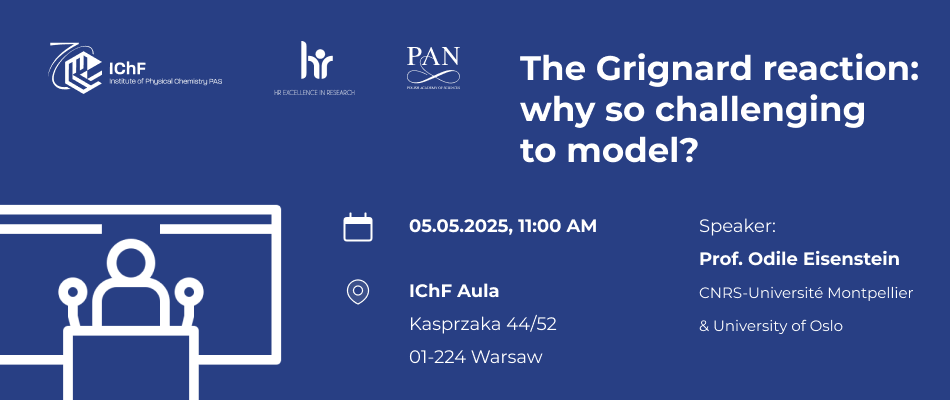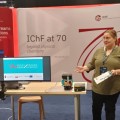The Grignard reaction: why so challenging to model?
Czas czytania: około 5 minut

We are pleased to invite you to a special lecture organized jointly by the Institute of Physical Chemistry PAS (IChF), the University of Warsaw, and the Polish Academy of Sciences. Prof. Odile Eisenstein, a distinguished theoretical chemist and the first female chemist elected to the French Academy of Sciences, will deliver a talk titled:
"The Grignard reaction: why so challenging to model?"
Date: Monday, May 5, 2025
Time: 11:00 AM
Venue: IChF Aula, Kasprzaka 44/52, 01-224 Warsaw
This is a unique opportunity to hear from a globally recognized leader in the field of theoretical chemistry. The abstract of the talk and a short biography of Prof. Eisenstein are attached to this invitation for your reference.
Attendance is mandatory for all Institute's PhD students and warmly encouraged for all researchers and staff. We look forward to seeing you there!
Odile Eisenstein is CNRS Research Professor Emeritus at the Université Montpellier and professor Emeritus from University of Oslo within the Hylleraas center. Born near Paris, she obtained her doctorate in 1977 at the University Paris-Sud (Orsay) with Nguyen Trong Anh and Lionel Salem. After post-doctoral positions with Jack Dunitz (ETH Zürich) and Roald Hoffmann (Cornell University) she returned to Orsay where she was CNRS research Associate Professor. She took a position of Assistant Professor at University of Michigan and returned to France where she was promoted to Research Professor. In 1996, she moved to University of Montpellier where she set up a laboratory of computational chemistry. She had numerous invited positions in the USA, UK, Spain, Israel, Japan and Norway. She received many awards including the CNRS silver medal, the Le Bel prize from the French Chemical Society, the Langevin award from the French Academy of Science, the ACS Organometallic Award, the Frankland and Centenary awards from the RSC. She holds several Honorary degrees (Indiana, Laval, Oslo, York, Technion) and is member of several Academies (France, Norway, Amer. Acad. Arts Sciences, US Nat. Acad. Sci., Royal Society). She is a member of the International Academy of Quantum Molecular Science and served at its president in 2018-2023. She is officier de la Légion d'Honneur et Commandeur de l’Ordre du Mérite. She uses computations to determine and understand the properties and reactivity of molecular species with a focus on organometallic compounds. She carries her research in a constant dialogue with experimentalists.
Abstract
Searching for the right model:
The case of the nucleophilic addition from the Felkin-Anh rule to the Grignard reaction
Odile Eisenstein
ICGM Université de Montpellier, CNRS ENSCM Montpellier France
Department of Chemistry and Hylleraas Center for Quantum Molecular Sciences, University of Oslo,
Norway
Odile.eisenstein@umontpellier.fr
The study of the Grignard reacIon is part of our long-standing interest in the study of nucleophilic
addiIon. Many years ago, calculaIons could be performed using very simplified models of the
reagents.[1] These very simplified models of the chemical systems were successful in providing
qualitaIve insights for many reacIons [2]. Today, it is possible to model reacIons using realisIc
representaIons of the chemical species and methods that represent properly the thermodynamics of
complex systems. Thus, we have studied the Grignard reacIon, a reacIon in which a Grignard
reagent, RMgX reacts with a carbonyl carbon by making a new C-R bond and form an alcohol aUer
hydrolysis. This reacIon, discovered in 1900 by Victor Grignard, enables the controlled formaIon of
C-C bond and is thus essenIal for organic synthesis in the academic and industrial laboratories alike.
It was honoured by a Nobel prize in 1912. In an aZempt to provide insights into a reacIon, which has
remained elusive despite extensive studies since its discovery in 1900, we have used ab iniIo
molecular dynamics to study the species that are present when CH3MgCl is added to an organic
solvent (tetrahydrofuran). We will present the arguments that led us to believe that the Grignard
reagent is present in a large number of forms in soluIon [3] and that the Grignard reacIon occurs via
numerous parallel pathways [4]. We pursue with the presentaIon of the complex structures of
lithium salts (LiX, X = halide) in organic solvant (5) with the goal to understand the role of addiIves
such as LiCl [6] in the reacIon (turbo-Grignard).
A perspecIve on this topic is available (7)
References
[1] O. Eisenstein Isr. J. Chem. 62, e202100138 (2022)
[2] O. Eisenstein Comptes Rendus Acad. Sciences 27, Special Issue S2, 5, (2024)
https://doi.org/10.5802/crchim.298
[3] R. M. Peltzer, O. Eisenstein, A. Nova, M. Cascella J. Phys. Chem. B 121, 4226 (2017)
[4] R. M. Peltzer, J. Gauss, O. Eisenstein, M. Cascella J. Am. Chem. Soc. 142, 2984 (2020)
[5] M. de Giovanetti, S. H. Hopen Eliasson, S. L. Bore, O. Eisenstein, M. Cascella Chem. Sci., 15, 20355
(2024)
[6] M. de Giovanetti, S. H. Hopen Eliasson, A. C. Castro, O. Eisenstein, M. Cascella J. Am. Chem. Soc.
145, 16305 (2023)
[7] M. Cascella, S. L. Bore, O. Eisenstein Chem. Sci. https://doi.org/10.1039/D5SC01078K

- Data wpisu: 30.04.2025





